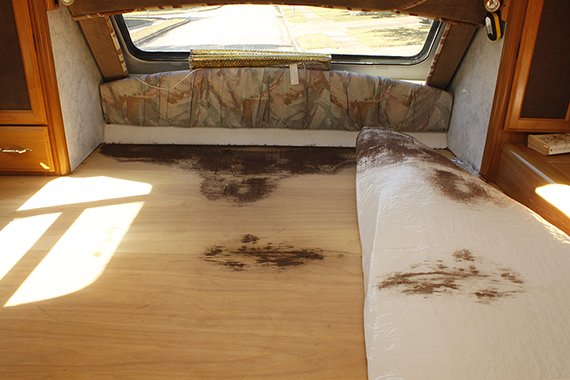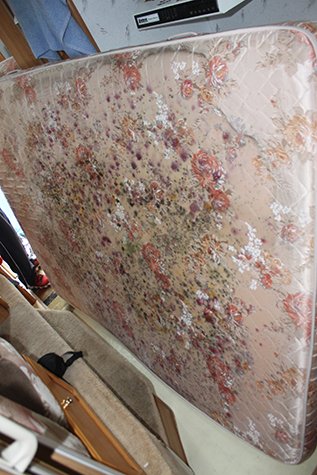dudeonthemove
New member
- Joined
- Dec 1, 2018
- Posts
- 2
UPDATE:
We did some more research and found that the cabinets are a structural element and that they are screwed through the roof and walls. We will leave the cabinets in place and try our to best to cut around them.
We have started to cut through the plywood and found out that it is glued down onto the joists so we are prying the platform off section by section. Unfortunately, there is mold on the joists as well, which we will try to bleach.
Although removing the moldy platform may not be the easiest nor cleanest method, but it may be the most surefire method. We will lay down new plywood, caulk the seams, paint on a sealer then ensure air flow under the new mattress. We will also be disinfecting all surfaces inside the camper, removing as much fabric and carpet as we can and laundering all our clothes.
When we found the mold, we bee-lined to our nearest relative in Texas. They are kind to let us stay in their mold-free home during this renovation. Things are progressing and we have a solid plan. Hopefully we will be back on the road soon.
Thanks all for reading my posts and chiming in. If you have any more tips or comments, please share.
Thanks.
ORIGINAL POST:
We have just discovered this disaster (see attached picture). Mold is seen all across the wood platform where we lay our heads. Clearly the platform will have to be replaced. We see that we have two options, either to do the work ourselves or bite the bullet and have it done professionally. I'd like to see how I can do it myself first.
I would like to replace the entire platform regardless of whether the mold is visibly present. The platform runs under the whole bed area including under each cabinet/closet.
How do I removed the cabinets? (I've poked my head around and can't seem to figure out how they are attached).
I hope someone with the right expertise and knowledge on how these things are built can point me in the right direction.
Thanks!
Christine
***
Some extra info:
- 2002 Lance 1121 Truck Camper (We bought it used in June 2018)
- Had the camper professionally re-caulked and sealed from a reputable company in early Oct. then started traveling full time in it 2 weeks later.
- During our travels, the escape hatch above the bed was leaking in the rain despite having had the whole camper professionally sealed. We caulked it ourselves early on before any damage was done (or so we thought).
- Our speculation is that unbeknownst to us, water had pooled on the bed platform prior to us inserting a mattress and starting our trip. The platform had a dark carpet so we must not have seen the water saturation when we put the mattress on top. 47 days later, unaware of all the water beneath us, we find the underside of our mattress covered in mold (see 2nd picture).
- Having found the mattress with mold, we pulled out the carpet and insulation beneath and found this disaster at the head of our bed, which we actually feel might be due to something else other than the leaking escape hatch and that it has been stewing since the previous owners had the camper. Maybe it's caused by condensation on the window above? I can't find an obvious reason. Any thoughts?
We did some more research and found that the cabinets are a structural element and that they are screwed through the roof and walls. We will leave the cabinets in place and try our to best to cut around them.
We have started to cut through the plywood and found out that it is glued down onto the joists so we are prying the platform off section by section. Unfortunately, there is mold on the joists as well, which we will try to bleach.
Although removing the moldy platform may not be the easiest nor cleanest method, but it may be the most surefire method. We will lay down new plywood, caulk the seams, paint on a sealer then ensure air flow under the new mattress. We will also be disinfecting all surfaces inside the camper, removing as much fabric and carpet as we can and laundering all our clothes.
When we found the mold, we bee-lined to our nearest relative in Texas. They are kind to let us stay in their mold-free home during this renovation. Things are progressing and we have a solid plan. Hopefully we will be back on the road soon.
Thanks all for reading my posts and chiming in. If you have any more tips or comments, please share.
Thanks.
ORIGINAL POST:
We have just discovered this disaster (see attached picture). Mold is seen all across the wood platform where we lay our heads. Clearly the platform will have to be replaced. We see that we have two options, either to do the work ourselves or bite the bullet and have it done professionally. I'd like to see how I can do it myself first.
I would like to replace the entire platform regardless of whether the mold is visibly present. The platform runs under the whole bed area including under each cabinet/closet.
How do I removed the cabinets? (I've poked my head around and can't seem to figure out how they are attached).
I hope someone with the right expertise and knowledge on how these things are built can point me in the right direction.
Thanks!
Christine
***
Some extra info:
- 2002 Lance 1121 Truck Camper (We bought it used in June 2018)
- Had the camper professionally re-caulked and sealed from a reputable company in early Oct. then started traveling full time in it 2 weeks later.
- During our travels, the escape hatch above the bed was leaking in the rain despite having had the whole camper professionally sealed. We caulked it ourselves early on before any damage was done (or so we thought).
- Our speculation is that unbeknownst to us, water had pooled on the bed platform prior to us inserting a mattress and starting our trip. The platform had a dark carpet so we must not have seen the water saturation when we put the mattress on top. 47 days later, unaware of all the water beneath us, we find the underside of our mattress covered in mold (see 2nd picture).
- Having found the mattress with mold, we pulled out the carpet and insulation beneath and found this disaster at the head of our bed, which we actually feel might be due to something else other than the leaking escape hatch and that it has been stewing since the previous owners had the camper. Maybe it's caused by condensation on the window above? I can't find an obvious reason. Any thoughts?


